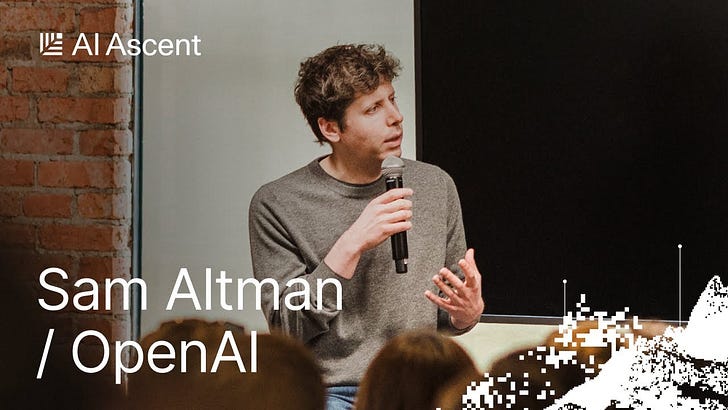OpenAI’s Sam Altman on Building the ‘Core AI Subscription’ for Your Life
Sam envisions transforming ChatGPT into a deeply personal AI service that remembers your entire life's context while working seamlessly across all services.
Post methodology: Dust custom assistant @AIAscentEssay using Claude 3.7 with system prompt: Please take the supplied transcript text and write a substack-style post about the key themes in the talk at AI Ascent 2025. Style notes: After the initial mention of a person, use their first name for all subsequent mentions; Do not use a first person POV in the posts. Light editing and formatting for the Substack platform.In a candid fireside chat, Sam Altman reflected on OpenAI's journey from a 14-person research lab to a company building what might become the internet's next major platform. Interviewed by Sequoia's Alfred Lin in the very office where OpenAI began in 2016, Sam shared insights on the company's evolution, product strategy, and his vision for AI's future.
The Accidental Product Journey
Sam shared OpenAI’s non-linear path to its breakthrough products. He characterized ChatGPT as something of a happy accident.
"One thing we did notice, which eventually led to ChatGPT, is even though people couldn't build a lot of great businesses with GPT-3 API, people loved to talk to it in the playground," Sam explained. "And it was terrible at chat... but people loved to do it anyway."
This observation—that people simply wanted to converse with AI models—proved pivotal. Despite GPT-3's limitations, the team's conviction that "people just want to talk to the model" grew stronger, eventually leading to ChatGPT's release on November 30, 2022.
Building at Scale: The Velocity Secret
With OpenAI now significantly larger, Sam addressed how the company maintains its impressive shipping velocity. His philosophy runs counter to conventional wisdom about organizational growth:
"I think a mistake that a lot of companies make is they get big and they don't do more things. So they just get bigger because you're supposed to get bigger and they still ship the same amount of product. And that's when the molasses really takes hold."
Instead, Sam advocates for keeping teams small and everyone busy: "You want to do a lot of things relative to the number of people you have. Otherwise, you just have like 40 people in every meeting and huge fights over who gets what tiny part of the product."
This approach has enabled OpenAI to maintain momentum even as it scales, with Sam noting they've "never felt more optimistic" about their research roadmap.
The Generation Gap in AI Adoption
Perhaps one of the most interesting insights came when Sam discussed how different generations use ChatGPT. He observed a stark divide:
"Older people use ChatGPT as a Google replacement. Maybe people in their 20s and 30s use it as a life advisor or something. And then people in college use it as an operating system."
The youngest users, according to Sam, have developed sophisticated workflows—connecting ChatGPT to files, memorizing complex prompts, and integrating it deeply into their decision-making processes. This generational adoption pattern mirrors what happened with smartphones, suggesting that AI tools may follow a similar trajectory of eventual mainstream integration.
The Future: From Assistants to Agents to Applications
Looking ahead, Sam sketched a vision where AI evolves beyond today's assistant model. He predicted a progression from current capabilities to more agentive AI that can take autonomous actions, and ultimately to application-like functionality.
When asked about the timeline for these developments, Sam offered a surprisingly specific roadmap:
"I kind of think 2025 will be a year of sort of agents doing work, coding in particular. I would expect [that] to be a dominant category...
Next year is a year where I would expect AIs discovering new stuff. And maybe we have AIs make some very large scientific discoveries or assist humans in doing that...
And then 2027, I would guess, is the year where that all moves from the sort of intellectual realm to the physical world. And robots go from a curiosity to a serious economic creator of value."
A Platform Vision Emerges
Throughout the conversation, Sam repeatedly returned to the idea of OpenAI becoming a platform—not just a product company. He envisions something that sounds remarkably like an operating system for AI: "We want to be people's core AI subscription and way to use that thing. Some of that will be like what you do inside of ChatGPT. We'll have a couple of other really key parts of that subscription, but mostly we will hopefully build this smarter and smarter model."
This platform approach extends to his vision of a new internet protocol "on the level of HTTP for the future of the internet, where things get federated and broken down into much smaller components, and agents are constantly exposing and using different tools and authentication, payment, data transfer."
The Resilience Required for the Journey
In a particularly poignant moment, Alfred asked Sam about resilience, referencing the tumultuous "blip" in OpenAI's history when Sam was briefly ousted as CEO. His response revealed the perspective that has helped him navigate OpenAI's challenges:
"It gets easier over time, I think. You will face a lot of adversity in your journey as a founder and the challenges get harder and higher stakes, but the emotional toll gets easier as you kind of go through more bad things."
Sam noted that the real challenge isn't the crisis itself, but the aftermath: "The thing that I think is harder to sort of manage your own psychology through is the fallout after... how you pick up the pieces."
Looking Forward
As OpenAI continues its ambitious growth—reportedly raising $40 billion at a $340 billion valuation—Sam maintains that there is "no master plan" beyond making great models and shipping good products. This pragmatic approach, coupled with the nimbleness to adjust tactics as the world changes, has served OpenAI well thus far. OpenAI's journey reflects both the breathtaking pace of AI development and the unexpected paths innovation often takes.



